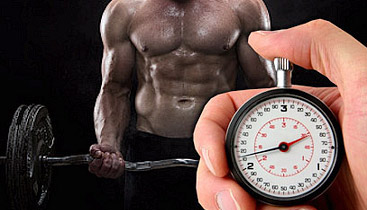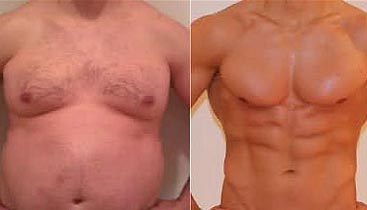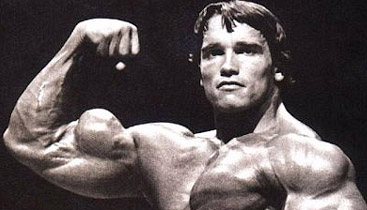BODYBUILDING AND FAT LOSS Q&A WITH SEAN NALEWANYJ: PART 4
Welcome to Part 4 of my Bodybuilding And Fat Loss Q&A series.
We’ve covered a lot of useful information so far and I hope you’ve been finding the various tips I’ve been discussing helpful.
There are still many more installments to come, and if you missed any of the previous 3, just use the links below to go back and access them…
Let’s jump in to the 5 question and answers for today…
Q: Is “time under tension” an important factor to pay attention to during each set, or is counting reps good enough?

A: Although the specific amount of time that your muscles spend under stress in any given set certainly does play some role when it comes to optimizing hypertrophy, it’s still not something that I would suggest you worry about.
TUT basically just tells us something we already know:
* Short sets performed in very low rep ranges are best suited for making strength gains.
* Long sets performed in very high rep ranges are best suited for improving muscular endurance.
* Sets that land somewhere in the middle between the two are best suited for increasing muscular hypertrophy.
However, the exact time frames that are typically outlined (such as “20 seconds for strength” or “60 seconds for hypertrophy”) are mainly just based on anecdote rather than any concrete science, and it’s not as if anyone actually knows for sure what the optimal time frames for each specific training goal are in the first place.
As long as you’re training within a standard bodybuilding rep range of anywhere from 5-12 per set and are executing your reps with a fast/explosive concentric and a reasonably controlled negative, you’ll likely land within the typical TUT “hypertrophy range” anyway.
Not only that, but basing your sets on a specific time goal may actually be counterproductive, as it will divert your focus away from the things that truly do matter during each set, such as proper rep speed, overall intensity, and a focus on progression in weight and reps.
Q:What is the ideal length of time that a bulking or cutting phase should last?

A: There is no such thing as an “optimal” time frame for any particular bulking or cutting phase, as it completely depends on each individual person and their specific situation.
If one’s primary goal is to put on muscle, then a bulking phase can continue for as long as it needs to until that person has either gained an amount of overall muscle size that they’re satisfied with, or until their body fat percentage has reached a level that they’re ultimately not comfortable with and want to reduce.
Depending on the individual, this could last for 8 weeks, 8 months or 8 years.
If the primary goal is to lose body fat, then a cutting phase can continue for whatever length of time is necessary for that individual to reach their desired level of leanness, or until they simply want to shift gears and add some muscle mass based on their personal preference of how they want to look.
Again, depending on the person, the time frame for this could vary all over the map.
If you want to lay out a set bulking and cutting cycle length for yourself right from the start just to get a rough idea of the time frames you might be dealing with, that’s fine.
However, just keep in mind that these will only be rough estimates, since there’s no way for you to predict what your exact rate of muscle growth or fat loss will be, how those changes will reflect in your actual physical appearance, or how your preferences might also change over time.
Q: What are the differences between freeweights, machines and cables when it comes to building muscle, and is one better than the other?

A: You’ll often get a typical black-and-white “free weights are king” response from many people when it comes to this question, but in reality, it’s not quite that simple and there’s no need to turn it into a “one or the other” argument in the first place.
When it comes down to it, free weights, machines and cables are all just individual items in your training toolbox and they each have their own specific application depending on the situation.
Sure, basic barbells and dumbbells are awesome training tools and probably will form the underlying foundation of your training routine, however, machines and cables definitely still have their place in a well-rounded hypertrophy-based program.
Since free weights rely only on the force of gravity as the source of resistance for each lift, some movements are simply better suited to machines and cables in order to maximize the tension on the targeted muscles.
This particularly applies to any exercise that is performed in a circular motion, such as chest flys, lateral raises, tricep extensions, curls, crunches etc.
Since the exercise is being performed in a circular motion but the resistance is always pulling straight up and down, you’ll always end up with an inconsistent resistance curve where there is either a high degree of tension in the first half of the range of motion but very little in the top half, or vice versa.
Machines and cables solve this issue by placing the resistance in the proper line to allow for full tension throughout the entire range of motion.
On top of this, machines can also be used to perform certain movements that are simply better suited to a machine variation or where they can’t even be replicated using free weights at all, such as leg presses, leg curls, leg extensions, standing calf raises, pulldowns, face pulls, tricep pressdowns etc.
In the end, none of these tools are inherently “better” than the other, and it just depends on which specific exercise you’re performing and what you’re trying to accomplish. Sometimes free weights are better suited, sometimes machines and cables are better suited, and your overall routine will likely contain a mix of all three.
Q: Does masturbation have any negative effect on muscle growth?

A: It may sound amusing to some people, but this is actually an extremely common bodybuilding question that I’ve been asked on a near-weekly basis ever since I first begin publishing fitness content online around 10 years ago.
Many guys worry that masturbation will have a negative impact on their muscle size and strength gains by lowering overall testosterone levels, and wonder if masturbating less frequently (or even abstaining altogether) is a smart idea.
The short answer is that, yes, when you do have sex or masturbate, you will experience a temporary drop in testosterone levels. However, that drop is then compensated for later on by an increase in testosterone, with overall levels essentially balancing themselves out in the big picture.
Always keep in mind that just because a particular activity “raises testosterone” or “lowers testosterone” does NOT necessarily mean that it will have any measurable impact on your muscle building results, since those levels need to be altered by quite a significant margin in order for it to be of any practical concern.
So, from a pure physical perspective of masturbation’s direct effects on testosterone levels and muscle growth, it’s really not something to concern yourself with.
That said, a case could be made for a potential link between masturbation and one’s muscle building or fat burning progress if you find that intentionally reducing your frequency has positive psychological effects in the way of improved energy, focus or motivation.
I don’t pretend to understand all of the science behind it, but from an anecdotal perspective, this does seem to be a very common experience that many guys report. However, this is something you’d have to experiment with and see if it has any noticeable effects for you.
Q: What are the best exercises and training techniques to build a bigger bicep peak?

A: The biceps are made up of two individual heads: the short head (the smaller, inner portion closest to your chest), and the long head (the larger, outer portion).
Since the long head is the portion that stands the tallest between the two, building a bigger bicep peak essentially comes down to adding more mass to this specific head.
Exercises that maximize the tension on the long head of the biceps would be any basic curling motion where your hands are in a supinated “palms up” position, such as barbell curls, dumbbell curls, cable curls and machine curls.
Although this might sound extremely simple, that’s really all there is to it.
As you add more overall mass to the long head through consistent bicep training, its “peak” will naturally improve, with its specific prominence being determined primarily by genetics.
Some people simply have shorter, “taller” biceps (due to the muscle inserting further away from the elbow), while others have longer, flatter biceps (due to the muscle inserting closer to the elbow), and there’s really nothing you can do to change that.
Mixing up your exercise selection, curling angles or rep ranges is not going to magically allow you to target the “middle” portion of the long head, and worrying about specifically training your arms for a bigger bicep peak is really just a waste of your effort.
Instead, just focus on building up your overall bicep size as a whole through proper workout structure and training form, and whatever particular “peak” you end up with from there is ultimately beyond your control.
That’s all for Part 4. Keep an eye out for Part 5 as I’ll have it posted within the next week. Talk to you then.
If you found this article helpful, make sure to sign up for your FREE custom fitness plan below...




